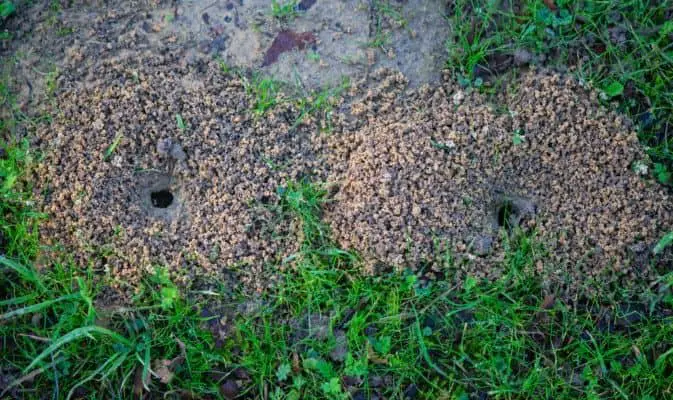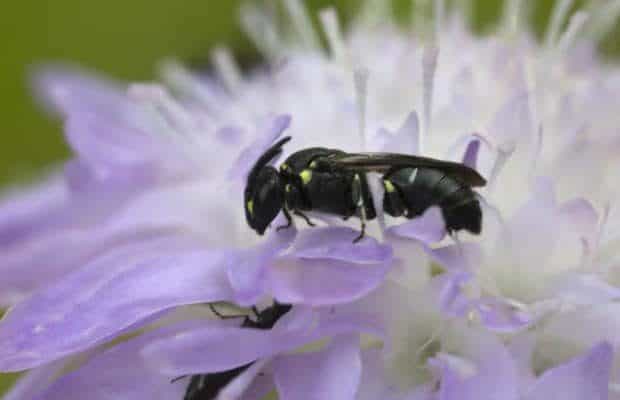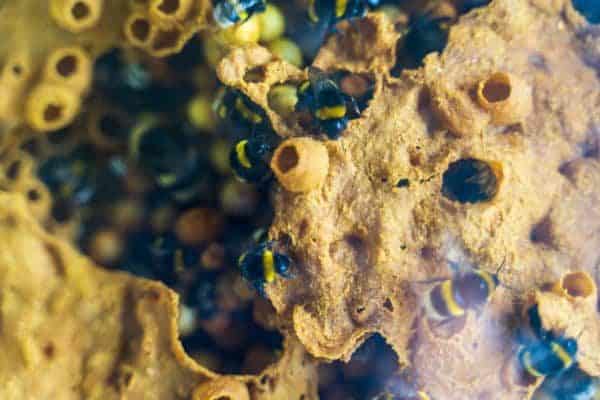Did you know that approximately 70% of all the 20,000 bee species choose to build their nests underground? This fact may seem surprising, but that’s mostly because there are so many species of bees, and the research available is still quite limited for about half of them.

Usually, when you think about these bumbling creatures, honey bees often come to mind, as they are the most popular of their kind. These busy and highly productive bees nest in hives, in most cases found in a secluded space where they can enjoy some form of protection.
But what about other bee species?
Some species burrow into the wood while other species nest in the ground. Some are social while others live on their own. While it will be impossible to cover every single species in one take, we’ll look at a few of them and their ecology.
The most common families of bees that nest underground can be classified as digger bees, sweat bees, and mining bees, with numerous species associated with these families.
Let’s look at a few of the interesting species of bees that nest in the ground.
What Do The Nests Look Like?
Colletid Bees
Colletid bees are also known as Polyester Bees, Cellophane Bees, or Plasterer bees. Polyester bees (Colletes inaequalis) are common in the United States and share a similar lifestyle to sweet bees and mining bees. Females are in charge of building the nests and generally create shallow brood cells of 4-6 inches in the ground.

The hole for the nest consists of a tunnel about a foot and a half deep, as wide as a pencil and it goes straight down into the ground. The cells are lined with a cellophane-like substance that can decompose in around five years.
This waterproofs the nest, allowing them to nest in wet areas. The substance is released from the bees’ Dufour gland and is secreted from the base of the sting.
Litigated Furrow Bee
The litigated furrow bee (Halictus ligatus) is part of the mining bee family and is a more social species.
Their nests are constructed either in rotting wood or in the ground. Also, a nest can consist of a few small cells, scattered cells, or clusters, depending on the number of bees living in the colony.
Nests are generally found in areas with dense vegetation. Their nests are lined with a waxy substance.
Bumblebees
There are approximately 250 species of these well-known bees in the world, many of which nest in the ground.
In fact, those that nest underground oftentimes nest in holes made by larger mammals such as mice.
Bumblebees prefer dry, dark cavities. Their colonies can include up to 400 bumblebees. The inside of a bumblebee nest can be quite messy and disorganized.

If you are interested in understanding more about how bumblebee nest, check out one of our other articles on this topic. Do Bumblebees Live Alone Or In Colonies?
Southern Blueberry Bees
These solitary bees are great pollinators for blueberry plants and nest in the ground.
Their burrows are found in sandy, loose soil, but sometimes underneath leaf litter or in the holes of walls.
The female builds a brood cell at the end of a thin tunnel slightly wider than her body size. A single egg is laid, and the chamber is sealed.
These bees produce one generation of bees per year. Each nesting chamber can also contain several rooms.
Squash Bees
Another interesting species is the squash bees – vital pollinators for squash plants.
Just like most other ground-nesting species, they are also solitary.
Male squash bees will sleep in flowers while the females will dig a nest in the ground. The nest will be a simple vertical tunnel a foot or two deep in the soil. A few individual chambers will come from this.
Every chamber will be filled with a pollen ball and an egg.
Alkali Bees
Another interesting species worth mentioning is alkali bees, a ground-nesting species that only nests in salty soil and plays a crucial role in the pollination of plants in the pea family, including alfalfa.
Honey bees do not pollinate alfalfa.
Females construct nests approximately 3-16 inches deep.
Cells branch off from these chambers and 15-20 of these cells can be contained in a single nest. These bees leave a pollen ball in each chamber with an egg on top of it.
Can You Identify The Species By The Nest?
It might not always be the easiest to identify ground-nesting bee species as there are so many different species nesting underground.
Most species will only leave a single hole visible above the ground as evidence, but in some cases, there might be small clues to provide better guidance.
Polyester Bee
According to MUSC, the nests of the polyester bee are very easy to identify above the ground as they become active.
A conical pile of dirt will be visible above the ground with a large hole in the middle.
It is one of the most plentiful bees in certain regions of North America and although solitary, females will nest in close proximity to one another.
Bumblebee
Bumblebee nests might be difficult to identify as they can nest in a variety of locations. These bees make a messy and disorganized nest.
They live in colonies and are not solitary. They are big and fuzzy, so you should spot the bumblebees first, making it easier to identify the nest site.
Southern Blueberry bees
Southern Blueberry bees for example will only leave a hole visible, which might make specific identification more difficult.
They are most likely found near blueberry orchids, though they can also pollinate other early flowering species.
Squash Bees
Squash bees might nest right underneath or near your cucurbit plants (baby marrow, pumpkin, etc), but other than this their nests might not be so easy to identify.
Alkali bees
Their nests are identifiable by small holes found on salty flats. They are solitary but gregarious and these bees will congregate and create nests sites in close proximity to one another.
Do They Live In The Nest All Year Round And When Can You See Them?
Most of these bees start the cycle as eggs and develop underground during the colder periods of the year. They then emerge as a bee as soon as the weather heats up in spring.
Polyester Bees
Female polyester bees will lay a single egg in a tunnel before closing it up. She will continue building more cells and laying more eggs.
The new bee will emerge in spring after going through several stages underground. Some sources claim that polyester bees are the first you see in spring and just about the last to be seen in autumn.
Litigated Furrow Bees
Female litigated furrow bees on the other hand will only emerge in late summer. Females then mate, overwinter, and create new nests at the onset of spring.
Nests are generally built by a single female, though some nests are found by two or three females.
In cases with more than one female, the larger female will act as the primary egg layer and guard the nest, while the others take care of the foraging.
Bumblebees
The bumblebee queen also emerges from hibernation in spring, so you can often see them searching for the perfect nesting during this time.
Bumblebees will naturally die off by the end of summer. The last bees will die in autumn. These bees generally also won’t nest in the same spot the following year.
Southern Blueberry Bees
Southern blueberry bees are most active from February to April or when blueberries flower. This bee uses sonication to eject pollen grains from the flowers, in other words, they enter the flower and vibrate to shake off pollen.
These bees are exceptional at pollination, so it is essential to create the perfect habitat at the edge of blueberry fields to encourage the bees.
Squash Bees
Squash bees can be seen in spring and summer when squash plants flower.
Do They Store Honey In Their Nests?
The honeybee gets its name due to the honey they produce. Very few of the ground-nesting bee species produce honey, though pollen and similar substances are used to feed the brood.
Polyester Bees
Instead of collecting pollen like many other bees, polyester bees create a type of soup – a concoction of nectar and pollen left at the base of the cell.
The eggs are then laid on the side of the wall and the larvae that emerge from the eggs fall in this concoction and start feeding.
Bumblebees
Bumblebees collect pollen and nectar from flowers just like honeybees, but their honey is not harvested at all as colonies are nowhere near the size of honeybees. The honey is used to feed the members inside the colony.
Squash Bees
Squash bees as well as numerous other species simply carry dry pollen to their nests, so there will not be any honey present.
Threats To Ground Nesting Bees
Living underground can be a risky business, but these ground-nesting bee species take some precautionary measures to safeguard the nest.
Rain/ Weather Events
For species like cellophane bees, a lot of water from rain does not matter as the substance used to line their nests is waterproof.
Plasterer bees do exactly the same to waterproof the nest with natural polyester. Many species ensure they seal off the top opening of the nest to protect the egg.
Predators
Birds, lizards, and frogs may choose to predate on these bees if the opportunity presents itself, just like these predators might predate on any other insect.
Some of these ground bees construct nests at night, so might attract the attention of frogs hunting in the dark.
Just like birds will predate on honeybees, they can also feast on these solitary bees during the day.
Parasites And Diseases
Many of these species are plagued by a number of parasites.
Flies can lay eggs in the tunnels, with the fly maggots then feasting on the newly hatched bee larvae.
Beetles already in the soil may come across the eggs and predate on them. Fungi present in the soil could infect the nest too.
Modern Farming/ Gardening Practices
Being a ground-nesting species, working the land can also pose another danger. Modern agriculture does not really leave room for undisturbed areas.
So while some of these native bees might be much better pollinators than honeybees, pesticides and destruction of areas suitable for these bees make them unsuitable in modern agricultural practices.
Raking your garden can also pose challenges to the hibernation habitat, for example, when it comes to bumblebees. Most queens overwinter just under the ground’s surface, so raking, tilling, and mowing should be avoided until April or May.
Squash bees often nest in the ground right near your pumpkins, so while growing these, do not use pesticides and avoid digging. You can also help these bees by planting your cucurbit plants in the same area year on year.
Are Ground Nesting Bees Aggressive?
Most ground-nesting bees are not aggressive at all.
Polyester bees will probably only sting if you sit on their nests and prevent them from emerging.
Bumblebees
Bumblebees can act defensively if their nest is disturbed, and could sting, but chances are very low.
Also, only females can sting, and male drones hovering around nests entrances looking to mate with females do not have stingers.
Squash Bees
Squash bees pose no danger and do not have stingers so can’t sting.
Can Honey Bees Nest In The Ground?
Honey bees will not nest in the ground in the same way as ground-nesting bees. Although they may choose a hole or tear in the ground or a rock crevice to build a hive, they will not dig holes in the ground to create underground hive networks.
We have a whole article on how and where honey bees make their hives. The article is, What Is A Beehive Made Of?
The Wrap Up
Although when most people think of a beehive they think of a honey-filled nest up in a tree, this is not true for most species.
Most bees will make a home in the ground over winter, and in fact, are usually better pollinators than the famous honeybee.
You should consider the solitary and ground-nesting bee population in and around your home, as this is without a doubt a huge advantage for diversity and pollination.
